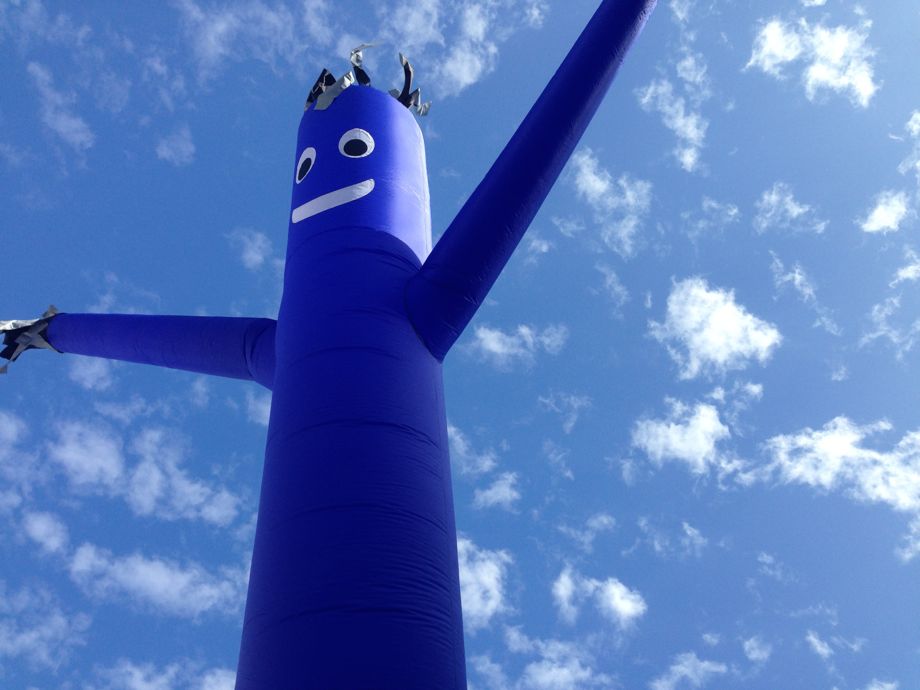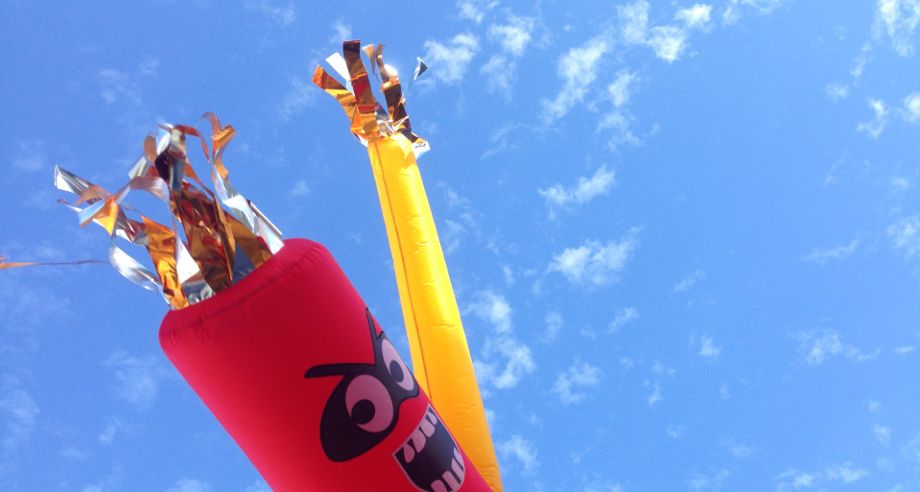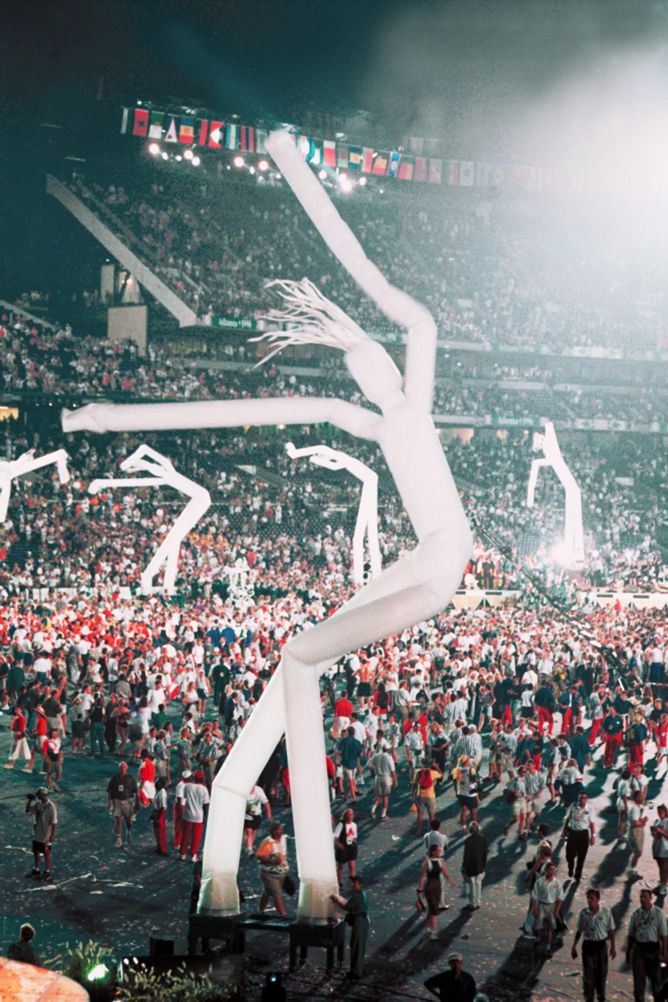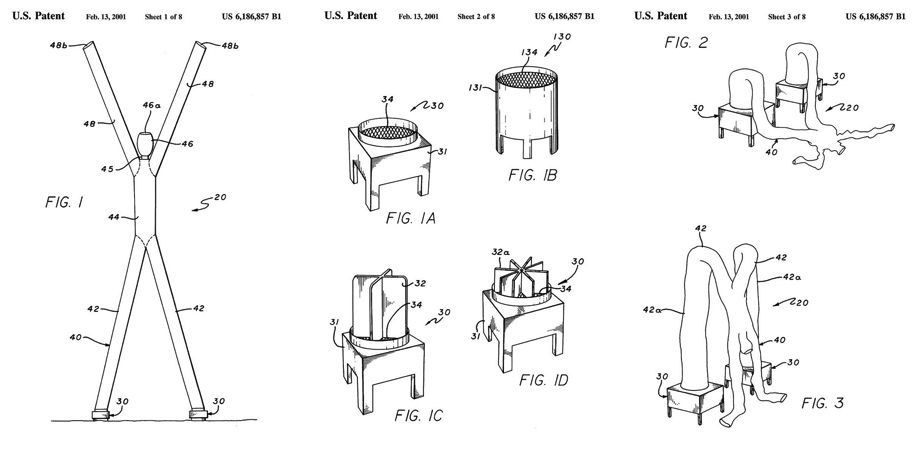The Caribbean Origins of the Dancing Inflatable Man

Courtesy of Sam Greenspan
Roman Mars’ podcast 99% Invisible covers design questions large and small, from his fascination with rebar to the history of slot machines to the great Los Angeles Red Car conspiracy. Here at The Eye, we cross-post new episodes and host excerpts from the 99% Invisible blog, which offers complementary visuals for each episode.
This week's edition—about inflatable men—can be played below. Or keep reading to learn more.
You see them on street corners, at gas stations, at shopping malls. You see them at blowout sales and grand openings of all kinds. Their wacky faces hover over us, fall down to meet us, and rise up again. Their bodies flop. They flail.
They are men. Men made of tubes. Tubes full of air.

Courtesy of Sam Greenspan
Beyond the streetscape, tube guys have popped up on TV:
They’ve become Internet memes:
You can even buy an inflatable tube man Halloween costume:
Depending upon your tastes, they are either full of ridiculous joyful exuberance or the tackiest thing in the world.
A number of cities across the U.S. have actually banned the use of tube guys. An ordinance in Houston enacted in 2008 proclaims that a dancing tube guy “contributes to urban visual clutter and blight and adversely affects the aesthetic environment.”
Some may see them as visual clutter now, but they have ancestry in stunning works of Caribbean art.
The tube guy origin story begins with celebrated artist and “mas man” Peter Minshall. He made a name for himself in Trinidad and Tobago (and beyond) for his Carnival bands, featuring larger-than-life puppets that dance through the street to the beat of Calypso music.
In the early 1990s, Minshall had gained fans among members of the planning committee for the Olympics. In 1995, he found himself in a stadium in Los Angeles working with a bunch of different artists, trying out different ideas for the opening ceremonies for the Atlanta Games the following year.
As Minshall tells it, he was trying to do something using inflatable tubes, but it wasn’t working. And then Minshall realized that if they were made to look like people, they would dance just like people did back home in Trinidad and Tobago—limpid, loose, and graceful.

Courtesy of Doron Gazit
Minshall and his team had conscripted a Los Angeles–based artist named Doron Gazit to realize the vision of the tube guys (or, as Minshall calls them, “tall boys”). Gazit was tapped for his experience working with inflatables, which he had done since his youth in Israel.
So Gazit and Minshall’s tube guys made an appearance in the 1996 Olympic opening ceremony, and that was the first the world had ever seen of these inflatable men. But how did they go from a thing we saw at the Olympics once—an art piece—to a thing you see at every used car lot in America?
After the Olympics, Gazit applied for a patent for “apparatus and method for providing inflated undulating figures” in 2001. He then began licensing its use through his company, Air Dimensional Designs.

Courtesy of the U.S. Patent and Trademark Office
This became a point of tension between Gazit and Minshall; Minshall had been unaware of Gazit’s intention to patent and monetize the inflatable figure. Gazit, for his part, says that he applied for a patent because he put a lot of research and development into making the “Fly Guys” (as Gazit calls them), and he was already starting to see other people rip off his efforts.
These days, Gazit has mostly moved on from these figures, though he does continue to work with inflatables. You may have seen his set design for Beyoncé’s 2013 Super Bowl halftime show:
However, Gazit’s company does continue to license its patent to various companies that manufacture and sell vertical inflatables. One such company is LookOurWay, which sells both “AirDancers” and “Air Rangers.”
Turns out that vertical inflatables also make for good scarecrows. Farmer Gary Long, who helped develop the Air Rangers, says that bird damage in his orchard of honey crisp apples went from 20,000 pounds a year to zero.
This episode was produced by Sam Greenspan, with additional reporting from Sam Dean, who wrote about the tube guys previously for Re:form.
To learn more, check out the 99% Invisible post or listen to the show.
99% Invisible is distributed by PRX.
